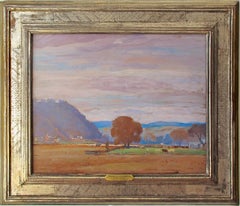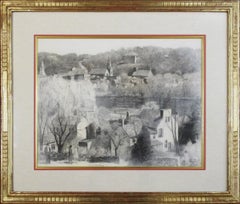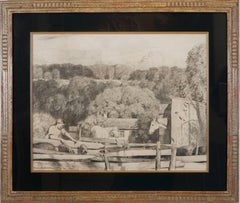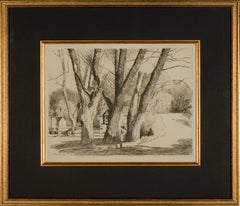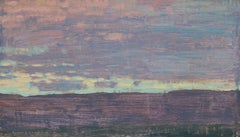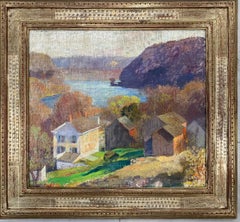Daniel Garber Art
to
4
4
4
1
1
2
Overall Height
to
Overall Width
to
4
1
1
1
15
2
2
2
4
15
79
77
70
60
2
1
1
1
1
Period: 1940s
Artist: Daniel Garber
"Up the Valley"
By Daniel Garber
Located in Lambertville, NJ
In an original Harer frame.
Illustrated in "Daniel Garber Catalogue Raisonne" Vol. II, pg. 271, and in book titled "Blue Chips", pg. 33
Jim’s of Lambertville is proud to offer this artwork by:
Daniel Garber (1880-1958)
One of the two most important and, so far, the most valuable of the New Hope School Painters, Daniel Garber was born on April 11, 1880, in North Manchester, Indiana. At the age of seventeen, he studied at the Art Academy of Cincinnati with Vincent Nowottny. Moving to Philadelphia in 1899, he first attended classes at the "Darby School," near Fort Washington; a summer school run by Academy instructors Anshutz and Breckenridge. Later that year, he enrolled at the Pennsylvania Academy of the Fine Arts. His instructors at the Academy included Thomas Anshutz, William Merritt Chase and Cecilia Beaux. There Garber met fellow artist Mary Franklin while she was posing as a model for the portrait class of Hugh Breckenridge. After a two year courtship, Garber married Mary Franklin on June 21, 1901.
In May 1905, Garber was awarded the William Emlen Cresson Scholarship from the Pennsylvania Academy, which enabled him to spend two years for independent studies in England, Italy and France. He painted frequently while in Europe, creating a powerful body of colorful impressionist landscapes depicting various rural villages and farms scenes; exhibiting several of these works in the Paris Salon.
Upon his return, Garber began to teach Life and Antique Drawing classes at the Philadelphia School of Design for Women in 1907. In the summer of that same year, Garber and family settled in Lumbertville, Pennsylvania, a small town just north of New Hope. Their new home would come to be known as the "Cuttalossa," named after the creek which occupied part of the land. The family would divide the year, living six months in Philadelphia at the Green Street townhouse while he taught, and the rest of the time in Lambertville. Soon Garber’s career would take off as he began to receive a multitude of prestigious awards for his masterful Pennsylvania landscapes. During the fall of 1909, he was offered a position to teach at the Pennsylvania Academy as an assistant to Thomas Anshutz. Garber became an important instructor at the Academy, where he taught for forty-one years.
Daniel Garber painted masterful landscapes depicting the Pennsylvania and New Jersey countryside surrounding New Hope. Unlike his contemporary, Edward Redfield, Garber painted with a delicate technique using a thin application of paint. His paintings are filled with color and light projecting a feeling of endless depth. Although Like Redfield, Garber painted large exhibition size canvases with the intent of winning medals, and was extremely successful doing so, he was also very adept at painting small gem like paintings. He was also a fine draftsman creating a relatively large body of works on paper, mostly in charcoal, and a rare few works in pastel. Another of Garber’s many talents was etching. He created a series of approximately fifty different scenes, most of which are run in editions of fifty or less etchings per plate.
Throughout his distinguished career, Daniel Garber was awarded some of the highest honors bestowed upon an American artist. Some of his accolades include the First Hallgarten Prize from the National Academy in 1909, the Bronze Medal at the International Exposition in Buenos Aires in 1910, the Walter Lippincott Prize from the Pennsylvania Academy and the Potter Gold Medal at the Art Institute of Chicago in 1911, the Second Clark Prize and the Silver Medal from the Corcoran Gallery of Art for “Wilderness” in 1912, the Gold Medal from the Panama-Pacific Exposition in San Francisco of 1915, the Second Altman Prize in1915, the Shaw prize in 1916, the First Altman Prize in 1917, the Edward Stotesbury Prize in1918, the Temple Gold Medal, in 1919, the First William A...
Category
1940s American Impressionist Daniel Garber Art
Materials
Panel, Oil
"View of Lambertville"
By Daniel Garber
Located in Lambertville, NJ
Jim’s of Lambertville Fine Art Gallery is proud to present this piece by Daniel Garber (1880 - 1958).
One of the two most important and, so far, the most valuable of the New Hope Sc...
Category
1940s American Impressionist Daniel Garber Art
Materials
Paper, Charcoal
"Pigs"
By Daniel Garber
Located in Lambertville, NJ
Jim’s of Lambertville Fine Art Gallery is proud to present this piece by Daniel Garber (1880 - 1958).
One of the two most important and, so far, the most valuable of the New Hope Sc...
Category
1940s American Impressionist Daniel Garber Art
Materials
Charcoal
"Spring Valley Willows"
By Daniel Garber
Located in Lambertville, NJ
Jim’s of Lambertville Fine Art Gallery is proud to present this piece by Daniel Garber (1880 - 1958).
One of the two most important and, so far, the most valuable of the New Hope School Painters, Daniel Garber was born on April 11, 1880, in North Manchester, Indiana. At the age of seventeen, he studied at the Art Academy of Cincinnati with Vincent Nowottny. Moving to Philadelphia in 1899, he first attended classes at the "Darby School," near Fort Washington; a summer school run by Academy instructors Anshutz and Breckenridge. Later that year, he enrolled at the Pennsylvania Academy of the Fine Arts. His instructors at the Academy included Thomas Anshutz, William Merritt Chase and Cecilia Beaux. There Garber met fellow artist Mary Franklin while she was posing as a model for the portrait class of Hugh Breckenridge. After a two year courtship, Garber married Mary Franklin on June 21, 1901.
In May 1905, Garber was awarded the William Emlen Cresson Scholarship from the Pennsylvania Academy, which enabled him to spend two years for independent studies in England, Italy and France. He painted frequently while in Europe, creating a powerful body of colorful impressionist landscapes depicting various rural villages and farms scenes; exhibiting several of these works in the Paris Salon.
Upon his return, Garber began to teach Life and Antique Drawing classes at the Philadelphia School of Design for Women in 1907. In the summer of that same year, Garber and family settled in Lumbertville, Pennsylvania, a small town just north of New Hope. Their new home would come to be known as the "Cuttalossa," named after the creek which occupied part of the land. The family would divide the year, living six months in Philadelphia at the Green Street townhouse while he taught, and the rest of the time in Lambertville. Soon Garber’s career would take off as he began to receive a multitude of prestigious awards for his masterful Pennsylvania landscapes. During the fall of 1909, he was offered a position to teach at the Pennsylvania Academy as an assistant to Thomas Anshutz. Garber became an important instructor at the Academy, where he taught for forty-one years.
Daniel Garber painted masterful landscapes depicting the Pennsylvania and New Jersey countryside surrounding New Hope. Unlike his contemporary, Edward Redfield, Garber painted with a delicate technique using a thin application of paint. His paintings are filled with color and light projecting a feeling of endless depth. Although Like Redfield, Garber painted large exhibition size canvases with the intent of winning medals, and was extremely successful doing so, he was also very adept at painting small gem like paintings. He was also a fine draftsman creating a relatively large body of works on paper, mostly in charcoal, and a rare few works in pastel. Another of Garber’s many talents was etching. He created a series of approximately fifty different scenes, most of which are run in editions of fifty or less etchings per plate.
Throughout his distinguished career, Daniel Garber was awarded some of the highest honors bestowed upon an American artist. Some of his accolades include the First Hallgarten Prize from the National Academy in 1909, the Bronze Medal at the International Exposition in Buenos Aires in 1910, the Walter Lippincott Prize from the Pennsylvania Academy and the Potter Gold Medal at the Art Institute of Chicago in 1911, the Second Clark Prize and the Silver Medal from the Corcoran Gallery of Art for “Wilderness” in 1912, the Gold Medal from the Panama-Pacific Exposition in San Francisco of 1915, the Second Altman Prize in1915, the Shaw prize in 1916, the First Altman Prize in 1917, the Edward Stotesbury Prize in1918, the Temple Gold Medal, in 1919, the First William A...
Category
1940s American Impressionist Daniel Garber Art
Materials
Etching
Related Items
"Parisian Nocturne, France, " Frank Edwin Scott, American Impressionism
By Frank Edwin Scott
Located in New York, NY
Edwin Frank Scott (1863 - 1929)
Parisian Noctune, France
Oil on woof panel
8 1/4 x 10 1/2 inches
Signed lower left
Born in Buffalo, New York, Edwin Frank ...
Category
Late 19th Century American Impressionist Daniel Garber Art
Materials
Oil, Wood Panel
"Evening View to the South West" , Oil Painting
By David Grossmann
Located in Denver, CO
David Grossman's (US based) "Evening View to the South West" is an original, handmade oil painting that depicts a wide open plain of the West with fields of...
Category
2010s American Impressionist Daniel Garber Art
Materials
Linen, Panel, Oil
Farmhouse by the Sea - Original Watercolor on Paper
Located in Soquel, CA
Farmhouse by the Sea - Original Watercolor on Paper
Tranquil landscape of a seaside farmhouse on the sand surrounded by coastal plants, in soft neutral watercolors. A distant ocean s...
Category
Late 20th Century American Impressionist Daniel Garber Art
Materials
Paper, Watercolor
Race Day
By John Terelak
Located in Greenwich, CT
American, b. 1942
John Charles Terelak is recognized as one of America's finest living impressionists. Born in Boston, Massachusetts, he received formal art instruction at the Vespe...
Category
2010s American Impressionist Daniel Garber Art
Materials
Oil, Panel
"Train Station, " Max Kuehne, Industrial City Scene, American Impressionism
By Max Kuehne
Located in New York, NY
Max Kuehne (1880 - 1968)
Train Station, circa 1910
Watercolor on paper
8 1/4 x 10 1/4 inches
Signed lower right
Provenance:
Private Collection, Illinois
Max Kuehne was born in Halle, Germany on November 7, 1880. During his adolescence the family immigrated to America and settled in Flushing, New York. As a young man, Max was active in rowing events, bicycle racing, swimming and sailing. After experimenting with various occupations, Kuehne decided to study art, which led him to William Merritt Chase's famous school in New York; he was trained by Chase himself, then by Kenneth Hayes Miller. Chase was at the peak of his career, and his portraits were especially in demand. Kuehne would have profited from Chase's invaluable lessons in technique, as well as his inspirational personality. Miller, only four years older than Kuehne, was another of the many artists to benefit from Chase's teachings. Even though Miller still would have been under the spell of Chase upon Kuehne's arrival, he was already experimenting with an aestheticism that went beyond Chase's realism and virtuosity of the brush. Later Miller developed a style dependent upon volumetric figures that recall Italian Renaissance prototypes.
Kuehne moved from Miller to Robert Henri in 1909. Rockwell Kent, who also studied under Chase, Miller, and Henri, expressed what he felt were their respective contributions: "As Chase had taught us to use our eyes, and Henri to enlist our hearts, Miller called on us to use our heads." (Rockwell Kent, It's Me O Lord: The Autobiography of Rockwell Kent. New York: Dodd, Mead and Co., 1955, p. 83). Henri prompted Kuehne to search out the unvarnished realities of urban living; a notable portion of Henri's stylistic formula was incorporated into his work.
Having received such a thorough foundation in art, Kuehne spent a year in Europe's major art museums to study techniques of the old masters. His son Richard named Ernest Lawson as one of Max Kuehne's European traveling companions. In 1911 Kuehne moved to New York where he maintained a studio and painted everyday scenes around him, using the rather Manet-like, dark palette of Henri.
A trip to Gloucester during the following summer engendered a brighter palette. In the words of Gallatin (1924, p. 60), during that summer Kuehne "executed some of his most successful pictures, paintings full of sunlight . . . revealing the fact that he was becoming a colorist of considerable distinction." Kuehne was away in England the year of the Armory Show (1913), where he worked on powerful, painterly seascapes on the rocky shores of Cornwall. Possibly inspired by Henri - who had discovered Madrid in 1900 then took classes there in 1906, 1908 and 1912 - Kuehne visited Spain in 1914; in all, he would spend three years there, maintaining a studio in Granada. He developed his own impressionism and a greater simplicity while in Spain, under the influence of the brilliant Mediterranean light. George Bellows convinced Kuehne to spend the summer of 1919 in Rockport, Maine (near Camden). The influence of Bellows was more than casual; he would have intensified Kuehne's commitment to paint life "in the raw" around him.
After another brief trip to Spain in 1920, Kuehne went to the other Rockport (Cape Ann, Massachusetts) where he was accepted as a member of the vigorous art colony, spearheaded by Aldro T. Hibbard. Rockport's picturesque ambiance fulfilled the needs of an artist-sailor: as a writer in the Gloucester Daily Times explained, "Max Kuehne came to Rockport to paint, but he stayed to sail." The 1920s was a boom decade for Cape Ann, as it was for the rest of the nation. Kuehne's studio in Rockport was formerly occupied by Jonas Lie.
Kuehne spent the summer of 1923 in Paris, where in July, André Breton started a brawl as the curtain went up on a play by his rival Tristan Tzara; the event signified the demise of the Dada movement. Kuehne could not relate to this avant-garde art but was apparently influenced by more traditional painters — the Fauves, Nabis, and painters such as Bonnard. Gallatin perceived a looser handling and more brilliant color in the pictures Kuehne brought back to the States in the fall. In 1926, Kuehne won the First Honorable Mention at the Carnegie Institute, and he re-exhibited there, for example, in 1937 (Before the Wind). Besides painting, Kuehne did sculpture, decorative screens, and furniture work with carved and gilded molding. In addition, he designed and carved his own frames, and John Taylor Adams encouraged Kuehne to execute etchings. Through his talents in all these media he was able to survive the Depression, and during the 1940s and 1950s these activities almost eclipsed his easel painting. In later years, Kuehne's landscapes and still-lifes show the influence of Cézanne and Bonnard, and his style changed radically.
Max Kuehne died in 1968. He exhibited his work at the National Academy of Design, the Art Institute of Chicago, the Carnegie Institute in Pittsburgh, the Memorial Art Gallery of the University of Rochester, and in various New York City galleries. Kuehne's works are in the following public collections: the Detroit Institute of Arts (Marine Headland), the Whitney Museum (Diamond Hill...
Category
1910s American Impressionist Daniel Garber Art
Materials
Paper, Watercolor
Shipping
By Kerr Eby
Located in Myrtle Beach, SC
Kerr Eby 'Shipping' also 'Shipping, Connecticut', etching and sandpaper ground, 1932, edition 100, Giardina 171. Signed in pencil and titled 'Shipping' in the bottom left sheet edge. A superb, atmospheric impression, with skillfully controlled plate tone, on heavy, cream wove paper; the full sheet with wide margins (2 to 2 3/4 inches), in excellent condition. Matted to museum standards, unframed.
Image size 8 3/8 x 17 1/4 inches (316 x 176 mm); sheet size 13 7/16 x 8 3/8 inches (341 x 213 mm).
The scene depicted was on the Connecticut coast...
Category
1940s American Impressionist Daniel Garber Art
Materials
Etching
"Still Life with Fruit" original charcoal drawing by Sylvia Spicuzza
By Sylvia Spicuzza
Located in Milwaukee, WI
In this drawing, Sylvia Spicuzza presents the viewer with a dark, subtle view of two apples, still clinging to their leaves. Examples like this show the ability of Spicuzza to draw i...
Category
1920s American Impressionist Daniel Garber Art
Materials
Paper, Charcoal
New Fish Market - NEW YORK
By Joseph Pennell
Located in Santa Monica, CA
JOSEPH PENNELL (1857 - 1926)
NEW FISH MARKET - (NEW YORK) 1921 (W 797)
Etching, Signed in pencil, edition probably 50. 9 7/8 x 6 7/8 inches. Full sheet, ...
Category
1920s American Impressionist Daniel Garber Art
Materials
Etching
The Sailor is a 11 x 8" oil Cuban-American Water Impressionism
By Reynier Llanes
Located in Houston, TX
REDUCED FROM $3000
The Sailor is a 11 x 8" oil painting by Cuban-American artist Reynier Llanes who lives in Miami. It is framed. It is oil painted on a wood panel . The Sailor floats in the frame. The background of Reynier Llanes is unique in style , subject matter, and medium.
The artist says this about Field of Flight The characters in my paintings emerge from stories and their journeys are inspired by my own experiences and daily routines. My inspiration comes from literature, music, cinema, and daily life. My daily routine enables me to meditate and use my creativity to serve these stories and inspirations. I begin my mornings with sketches and watercolors. This is the time I use to keep inventory of my ideas and to allow them to further inspire me. Many of these characters have been depicted in my work before, whether in a different geographical location or in a different state of their physical evolution. I use a variety of mediums in my work including oils, watercolors, coffee, and charcoal. They are all equally important to me as they allow me full expression, each in its’ own sector.
I use a great deal of symbolism in my art to give depth to the subjects that I wish to express. I want my art to tell a story in a manner that stimulates the imaginations of others, especially of things never seen or expressed directly. As an observer it is clear to see that we are all in pursuit of life’s mission of working, loving, and belonging. I begin my paintings by building layers of textures and color values, and then subtly add dimension and depth. Through the use of colors and highlighting I am able to enhance the atmosphere with mood, character, depth and mystery, and bring special attention to my subjects. It is the creative process of using these materials and methods that feed my soul, life, and being. I believe it is our mission as intellectuals to have a voice in our society, for our work to have a footprint in history, and to be a reference for future generations.
BIO:
Reynier Llanes was born in Pinar del Rio, Cuba in 1985. He attended the city’s school of art (Instructores de Arte) for four years and completed his studies in 2004. Llanes was tutored by one of the country’s most recognized realist artists, Juan Miguel Suárez. In 2005 he moved to Havana where he continued his studies and collaborated with various artists. The capital was a thriving mecca of art and culture and the museums the grounds for inspiration.
In 2007 LIanes availed himself of an opportunity to emigrate from Cuba and moved to the United States, first settling in Naples, FL. In Naples he began to introduce his work in a major exhibition entitled “Strange Visitor” at the Kapo Maestro Gallery. In 2009 he relocated to Charleston, SC where he had the honor of being granted an artist in residency at the Jonathan Green Studios.
Llanes was awarded a "first purchase award" for a piece now in the art collection of the city of Charleston 2011 at Moja Art Festival Juried Exhibition Award. In 2012 Oxford America recognized him as one of the "New Superstars of Southern Art." The art of Reynier was nourished by the rich southern culture and he began to collaborate with various museums and art centers. His work was featured in a traveling exhibition The Vibrant Vision Collection at the Morris Museum in Augusta, GA and the Gibbes Museum of Art in Charleston, SC.
Llanes is also an avid art collector in his own right, focusing on works by artists from Cuba, and particularly those from his native province of Pinar del Río. A selection of works from his collection was exhibited at City Gallery in Charleston in 2013 and in the Art Museum in Myrtle Beach in 2015.
In 2015 Llanes relocated with his family to Miami in order to take advantage of the city’s international art market and vibrant cultural life and to be closer to his home country. South Florida is, of course, home to a large community of intellectuals, collectors, and fellow artists who have welcomed Llanes into their cosmopolitan scene. His first solo exhibition in Miami took place at Miami Dade College West, this exhibition was entitled “Preserving Cultural Heritage” and it featured a large collection of coffee paintings.
In 2017 he met Bill Meek...
Category
2010s American Impressionist Daniel Garber Art
Materials
Wood Panel, Oil
H 11 in W 8 in D 1.5 in
Pine trees in a river valley with the Blue Ridge Mountains - American School
Located in Middletown, NY
An unfinished but spirited plein-air composition of what appears to be the Shenandoah or Potomac River valley with the Blue Ridge Mountains in the distance.
Watercolor on board with...
Category
Early 1900s American Impressionist Daniel Garber Art
Materials
Crayon, Watercolor, Board
"Cloudy Dock Scene", working peir with fishermen, boats, and architecture
By John Cuthbert Hare
Located in Rockport, MA
John Cuthbert Hare was an accomplished New England painter born in Brooklyn, New York. He began his artistic journey by studying commercial art at the Pratt Institute in New York Cit...
Category
Mid-20th Century American Impressionist Daniel Garber Art
Materials
Paper, Watercolor
untitled (Maine Autumn Landscape across the narrows from Mt. Desert)
By Greta Allen
Located in Fairlawn, OH
untitled (Maine Autumn Landscape across the narrows from Mt. Desert)
Watercolor, 1945-1955
Signed by the artist lower left in pencil (see photo)
Provenance: Estate of the artist
Cond...
Category
1940s American Impressionist Daniel Garber Art
Materials
Watercolor
Previously Available Items
"From Carey's Hill"
By Daniel Garber
Located in Lambertville, NJ
Jim’s of Lambertville is proud to offer this artwork by:
Daniel Garber (1880-1958)
One of the two most important and, so far, the most valuable of the New Hope School Painters, Da...
Category
1940s American Impressionist Daniel Garber Art
Materials
Canvas, Oil
Daniel Garber art for sale on 1stDibs.
Find a wide variety of authentic Daniel Garber art available for sale on 1stDibs. You can also browse by medium to find art by Daniel Garber in etching, paper, charcoal and more. Much of the original work by this artist or collective was created during the 20th century and is mostly associated with the Impressionist style. Not every interior allows for large Daniel Garber art, so small editions measuring 9 inches across are available. Customers who are interested in this artist might also find the work of Louis Oscar Griffith, Robert Hallowell, and Childe Hassam. Daniel Garber art prices can differ depending upon medium, time period and other attributes. On 1stDibs, the price for these items starts at $4,575 and tops out at $993,750, while the average work can sell for $28,125.
